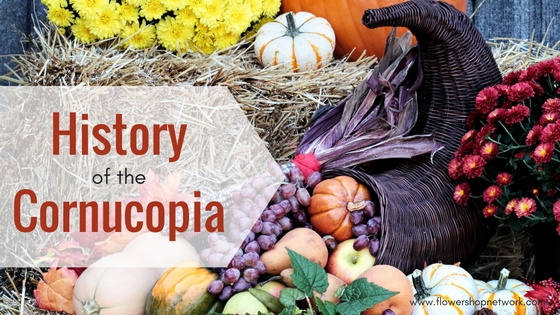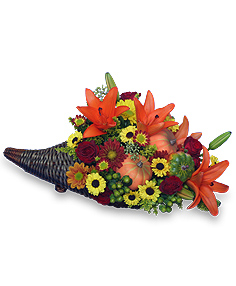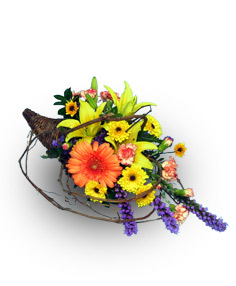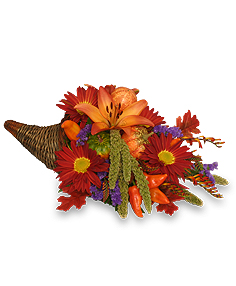The cornucopia is a cultural icon used in decorative flower arrangements around Thanksgiving. This holiday staple is more than just a classic centerpiece. Keep reading to take a glimpse into the past and see why this unique item has become a symbol of our thankfulness in America.
History of the Cornucopia
Decorate Your Thanksgiving With A Plentiful Cornucopia
Cornucopias are awesome. They are unique, beautiful and bountiful. They are traditional representations of Thanksgiving. What’s not to love?
Did you know that the cornucopia is rich in history and is as much as strong symbol of Greek mythology as it is a representation of the American Thanksgiving? Yeah. I didn’t either until I began to search for ideas online that my local florist could use. I’m not super crafty so I figured I’d rely on the experts for this one. That aside, here’s a brief history of cornucopias.
A Brief History of Cornucopias: (told you)
The cornucopia’s history can be traced as far back as the fifth century B.C. Obviously that’s a bit longer than the early days of the American colonies. Though the mythology varies after centuries of retelling, Greek legend has it that the first cornucopia belonged to Amalthea. If you ever wondered who nursed Zeus as a baby, it was the nymph Amalthea. She used a goat’s horn that had broken off and filled it with her breast milk so that Zeus could suckle.
One legend states that Amalthea was a goat herself and the horn was hers broken off by Zeus as they were playing together. He felt bad and gave it back to her,now retrofitted with supernatural powers. The power, as all of the legends concur, had the ability to fill itself with whatever the owner wished. It became a symbol of plenty and that’s how it earned many of its nicknames.
See? The story is really quite interesting. I wonder how many of the pilgrims knew the legend and used cornucopias for this reason (their representation of plenty, abundance). As they were religious pilgrims under the Christian religion, I doubt they modeled their celebration after Greek mythology but it’s an interesting speculation nonetheless. What do you think?
This Thanksgiving, why not decorate your table with a plentiful cornucopia surrounded by fresh flowers. Not only will the fragrance smell as good as dinner, but it will also be a festive decoration that will be a surefire conversation starter.
To buy cornucopias for your table, use FlowerShopNetwork.com to contact your local florist. You may also click the picture of your favorite cornucopia to buy one from your local florist. [Read more…]
5 Flower Arrangements Perfect For Thanksgiving – Including Pictures
Here are my 5 favorite Thanksgiving Flower Arrangements.

I love this cornucopia Thanksgiving flower arrangement; sometimes referred to as a Horn of Plenty arrangement. I use this on the buffet table in my kitchen. I place it in the center of the table and arrange the appetizers around it.
Cornucopia – The Horn of Plenty
Cornucopia Name
The cornucopia is a time-honored symbol of abundance, long associated with Thanksgiving. However, it was symbolic well before this holiday existed. The word ‘cornucopia’ actually dates back to the 5th century BC. It derives from two Latin words: “cornu,” meaning horn (as in the name of that one-horned creature, the “unicorn”) and “copia,” meaning plenty (a relative of such words as “copious” and “copy”). Thus, “cornucopia” literally means horn of plenty, and the names are used interchangeably. It was usually depicted as a curved goat’s horn, filled to overflowing with fruit and grain, but could actually have been filled with whatever the owner wished.
Cornucopia History – The Legend of Hercules & Achelous
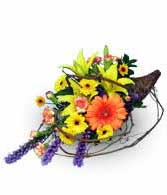 Still, have you ever wondered how this copious horn came to be? There are two historically understood origins of the cornucopia, and both come from Greek mythology. The first involves a feud between the renowned he-man, Hercules and the river-god, Achelous, the greatest river in Greece. The two were suitors for Dejanira, a young maiden of extraordinary beauty who was the daughter of King Oeneus of Calydon. The competition (the legendary Fifth Labor of Hercules) amounted to a colossal wrestling match, during which Hercules repeatedly gained the upper hand. Achelous, who was able to change his physical form, changed first into a snake, and then into a bull in order to gain leverage against Hercules. While Achelous was in bull form, Hercules tore off one of his horns and in doing so, diverted the river. The Naiads (nubile water-nymphs) treated the horn as a sacred object, filling it with fragrant flowers. The Goddess of Plenty (Copia) later adopted the horn, and dubbed it (appropriately enough) The Horn of Plenty, or Cornucopia. Incidentally, Hercules later married Dejanira and the two produced an abundance of children.
Still, have you ever wondered how this copious horn came to be? There are two historically understood origins of the cornucopia, and both come from Greek mythology. The first involves a feud between the renowned he-man, Hercules and the river-god, Achelous, the greatest river in Greece. The two were suitors for Dejanira, a young maiden of extraordinary beauty who was the daughter of King Oeneus of Calydon. The competition (the legendary Fifth Labor of Hercules) amounted to a colossal wrestling match, during which Hercules repeatedly gained the upper hand. Achelous, who was able to change his physical form, changed first into a snake, and then into a bull in order to gain leverage against Hercules. While Achelous was in bull form, Hercules tore off one of his horns and in doing so, diverted the river. The Naiads (nubile water-nymphs) treated the horn as a sacred object, filling it with fragrant flowers. The Goddess of Plenty (Copia) later adopted the horn, and dubbed it (appropriately enough) The Horn of Plenty, or Cornucopia. Incidentally, Hercules later married Dejanira and the two produced an abundance of children.
Ancient peoples were fond of uncovering hidden meanings in their mythological tales. The battle between Achelous and Hercules is explained by saying Achelous was a river that overflowed its banks during rainy seasons. [Read more…]


 Find Your
Find Your 